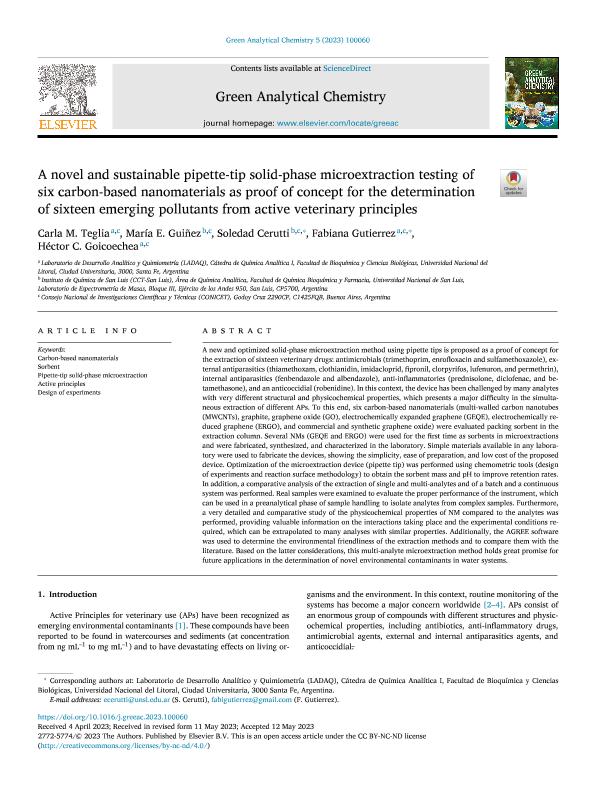Mostrar el registro sencillo del ítem
dc.contributor.author
Teglia, Carla Mariela

dc.contributor.author
Guiñez, María Evangelina

dc.contributor.author
Cerutti, Estela Soledad

dc.contributor.author
Gutierrez, Fabiana Andrea

dc.contributor.author
Goicoechea, Hector Casimiro

dc.date.available
2023-08-17T19:19:20Z
dc.date.issued
2023-06
dc.identifier.citation
Teglia, Carla Mariela; Guiñez, María Evangelina; Cerutti, Estela Soledad; Gutierrez, Fabiana Andrea; Goicoechea, Hector Casimiro; A novel and sustainable pipette-tip solid-phase microextraction testing of six carbon-based nanomaterials as proof of concept for the determination of sixteen emerging pollutants from active veterinary principles; Elsevier Science; Green Analytical Chemistry; 5; 100060; 6-2023; 1-11
dc.identifier.issn
2772-5774
dc.identifier.uri
http://hdl.handle.net/11336/208660
dc.description.abstract
A new and optimized solid-phase microextraction method using pipette tips is proposed as a proof of concept for the extraction of sixteen veterinary drugs: antimicrobials (trimethoprim, enrofloxacin and sulfamethoxazole), external antiparasitics (thiamethoxam, clothianidin, imidacloprid, fipronil, clorpyrifos, lufenuron, and permethrin), internal antiparasitics (fenbendazole and albendazole), anti-inflammatories (prednisolone, diclofenac, and betamethasone), and an anticoccidial (robenidine). In this context, the device has been challenged by many analytes with very different structural and physicochemical properties, which presents a major difficulty in the simultaneous extraction of different APs. To this end, six carbon-based nanomaterials (multi-walled carbon nanotubes (MWCNTs), graphite, graphene oxide (GO), electrochemically expanded graphene (GEQE), electrochemically reduced graphene (ERGO), and commercial and synthetic graphene oxide) were evaluated packing sorbent in the extraction column. Several NMs (GEQE and ERGO) were used for the first time as sorbents in microextractions and were fabricated, synthesized, and characterized in the laboratory. Simple materials available in any laboratory were used to fabricate the devices, showing the simplicity, ease of preparation, and low cost of the proposed device. Optimization of the microextraction device (pipette tip) was performed using chemometric tools (design of experiments and reaction surface methodology) to obtain the sorbent mass and pH to improve retention rates. In addition, a comparative analysis of the extraction of single and multi-analytes and of a batch and a continuous system was performed. Real samples were examined to evaluate the proper performance of the instrument, which can be used in a preanalytical phase of sample handling to isolate analytes from complex samples. Furthermore, a very detailed and comparative study of the physicochemical properties of NM compared to the analytes was performed, providing valuable information on the interactions taking place and the experimental conditions required, which can be extrapolated to many analyses with similar properties. Additionally, the AGREE software was used to determine the environmental friendliness of the extraction methods and to compare them with the literature. Based on the latter considerations, this multi-analyte microextraction method holds great promise for future applications in the determination of novel environmental contaminants in water systems.
dc.format
application/pdf
dc.language.iso
eng
dc.publisher
Elsevier Science

dc.rights
info:eu-repo/semantics/openAccess
dc.rights.uri
https://creativecommons.org/licenses/by-nc-nd/2.5/ar/
dc.subject
ACTIVE PRINCIPLES
dc.subject
CARBON-BASED NANOMATERIALS
dc.subject
DESIGN OF EXPERIMENTS
dc.subject
PIPETTE-TIP SOLID-PHASE MICROEXTRACTION
dc.subject
SORBENT
dc.subject.classification
Química Analítica

dc.subject.classification
Ciencias Químicas

dc.subject.classification
CIENCIAS NATURALES Y EXACTAS

dc.title
A novel and sustainable pipette-tip solid-phase microextraction testing of six carbon-based nanomaterials as proof of concept for the determination of sixteen emerging pollutants from active veterinary principles
dc.type
info:eu-repo/semantics/article
dc.type
info:ar-repo/semantics/artículo
dc.type
info:eu-repo/semantics/publishedVersion
dc.date.updated
2023-06-21T20:37:32Z
dc.journal.volume
5
dc.journal.number
100060
dc.journal.pagination
1-11
dc.journal.pais
Países Bajos

dc.journal.ciudad
Ámsterdam
dc.description.fil
Fil: Teglia, Carla Mariela. Universidad Nacional del Litoral. Facultad de Bioquímica y Ciencias Biológicas; Argentina. Consejo Nacional de Investigaciones Científicas y Técnicas. Centro Científico Tecnológico Conicet - San Luis. Instituto de Química de San Luis. Universidad Nacional de San Luis. Facultad de Química, Bioquímica y Farmacia. Instituto de Química de San Luis; Argentina
dc.description.fil
Fil: Guiñez, María Evangelina. Consejo Nacional de Investigaciones Científicas y Técnicas. Centro Científico Tecnológico Conicet - San Luis. Instituto de Química de San Luis. Universidad Nacional de San Luis. Facultad de Química, Bioquímica y Farmacia. Instituto de Química de San Luis; Argentina
dc.description.fil
Fil: Cerutti, Estela Soledad. Consejo Nacional de Investigaciones Científicas y Técnicas. Centro Científico Tecnológico Conicet - San Luis. Instituto de Química de San Luis. Universidad Nacional de San Luis. Facultad de Química, Bioquímica y Farmacia. Instituto de Química de San Luis; Argentina
dc.description.fil
Fil: Gutierrez, Fabiana Andrea. Consejo Nacional de Investigaciones Científicas y Técnicas. Centro Científico Tecnológico Conicet - San Luis. Instituto de Química de San Luis. Universidad Nacional de San Luis. Facultad de Química, Bioquímica y Farmacia. Instituto de Química de San Luis; Argentina
dc.description.fil
Fil: Goicoechea, Hector Casimiro. Universidad Nacional del Litoral. Facultad de Bioquímica y Ciencias Biológicas; Argentina. Consejo Nacional de Investigaciones Científicas y Técnicas. Centro Científico Tecnológico Conicet - San Luis. Instituto de Química de San Luis. Universidad Nacional de San Luis. Facultad de Química, Bioquímica y Farmacia. Instituto de Química de San Luis; Argentina
dc.journal.title
Green Analytical Chemistry
dc.relation.alternativeid
info:eu-repo/semantics/altIdentifier/url/https://www.sciencedirect.com/science/article/pii/S2772577423000125
dc.relation.alternativeid
info:eu-repo/semantics/altIdentifier/doi/https://doi.org/10.1016/j.greeac.2023.100060
Archivos asociados
